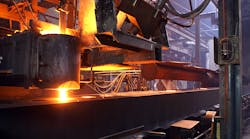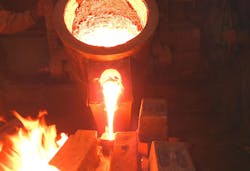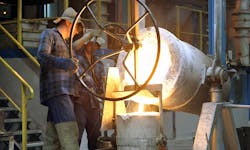Steel producers have long recognized the role that free oxygen atoms play in the formation of defects in their finished products. Appliance-grade steels, deep-draw can steels, and many other grades cannot tolerate surface blemishes or defects. Steel industry metallurgists determined the defect-formation is directly correlated to free-oxygen content in steel, prompting them to go to extremes in their efforts to shroud molten steel from atmospheric contact.
Despite the effort, iron oxide tenaciously formed and steel became contaminated, leading the steelmakers to add aluminum to tie up oxygen in critical applications.
Iron foundries are prevented from using aluminum to minimize defects because the 0.03% Al level needed to tie up all free oxygen atoms in steel production will lead to gas porosity in cast iron.
Many foundry metallurgists simply disregard free-oxygen levels in molten iron: They do not have the technology to remove free-oxygen atom contamination, so they let it be. Free-oxygen removal has been accomplished only by vacuum treatment. No practical general process or technique has been available to remove free oxygen atoms from molten iron, until the introduction of DeOX Metal Treatment.
Free-oxygen levels — Oxygen atom levels nearing 1 part-per-million (PPM) in steel reach oxygen’s inert behavior level, the point at which no “oxidation” occurs. Steelmakers have proven oxygen levels exceeding 1 PPM cause surface defects; 2 PPM oxygen produces a 2% defect rate; and 3 PPM oxygen produces 4% defects.
In iron, oxygen’s inert level nears 2.4 PPM, which is higher than the inert level for steel, the elevation being due to the higher chemical composition of iron. However, common levels of free oxygen in iron typically cast into molds by iron foundries exceed 5-8 PPM. These high levels of free oxygen cause defect formation, a detail that unfortunately is unknown to foundry technologists worldwide.
There are many consequences of free-oxygen atom contamination, all are profound and all are bad. They range from producing surface defects, producing oxidation losses during the melting process, reducing iron fluidity, reducing mechanical strength and elongation, drastically decreasing machinability, and many, many more. The oxygen atoms’ presence in molten iron is always detrimental, never beneficial.
Free-oxygen atoms are highly charged and highly reactive, and aggressively combine to form oxide molecules throughout the molten iron bath. Oxide formation is a continuous and ongoing process, stopping only when the oxygen atom supply is depleted or solidification occurs. Once the oxygen atom is liberated into the iron bath through the iron-oxide equilibrium reaction, its oxidation of other elements within that bath cannot be stopped. All elements within the bath are subject to oxidation. The Laws of Thermodynamics control each element's reaction rate with the oxygen atoms present.
Instant reaction — Oxide formation occurs at the nano or atomic level. The oxides formed are very small, but these oxides agglomerate or coalesce quickly into much larger masses. When they reach a critical size, the agglomerated mass floats to the metal surface. That entire sequence, ending in oxide floatation, occurs in seconds. If the floating action occurs in the furnace, transfer vessel, or pouring ladle, silica-rich slag forms on the molten metal’s surface. If the oxide floatation occurs in the casting mold, casting surface defects form.
This oxide floatation phenomenon is illustrated by iron melting in coreless furnaces. Overall slag volume occurring during iron melting is reduced by 75% when low free-oxygen metal is produced. The startling reduction in slag volume results from elimination of silicon oxidation in the metal. The SiO2, which was normally formed, is absent, which reduces any slag produced to simply melting of dirt and surface contamination in the charge materials.
Oxide formation, the “oxidation” process, is a continuous and ongoing process. The only way to stop it is to cut off the supply of free oxygen atoms.
Mastermelt’s DeOX Metal Treatment cuts off the supply of oxygen atom by chemically reducing iron oxide to inert by-products. Iron oxide contacting the molten iron supplied the free oxygen atoms. Once iron oxide is dealt with effectively, free-oxygen atom contamination levels in molten iron quickly lowers to the inert level of oxygen activity. No oxides are formed at oxygen’s inert level. DeOX Metal Treatment neutralizes iron oxide, curtailing free-oxygen atoms’ deleterious effects.
Low free-oxygen-level iron is typically free of surface defects. Common defects of iron castings, such as sand inclusion, dirt, slag, dross, blow, pinhole, and misrun, disappear from the scrap charts.
Low free-oxygen iron is a new material, never encountered by most foundry technologists. You must encounter it to believe it.
Low free-oxygen iron, DeOX-treated iron, eliminates that portion of casting scrap associated with surface defects. DeOX commonly lowers casting scrap levels to 1%-2.5%. Several examples are cited below:
• Foundry A: +1500 tons iron cast per day; Scrap level before low-free-oxygen iron = 3.0%; Scrap level with low-free-oxygen iron = 1.0%.
• Foundry B: 500 tons heavily cored iron cast per day; Scrap level before low-free-oxygen iron = 7%; Scrap level with low-free-oxygen level iron = 3%
• Foundry C: 200 tons iron cast per day; Scrap level before low-free-oxygen iron = 7%; Scrap level after low-free-oxygen level iron = 2.5%.
• Foundry D: 400 tons iron pipe cast per day; Scrap level before low-free-oxygen = 7.5%. Scrap level with low-free-oxygen iron = 2.5%.
Case by case — In each of these cases, when the low-free-oxygen iron supply was stopped or altered, casting scrap rates immediately responded, increasing and returning to previous scrap-rate levels. In the case of the 1,500-tpd foundry, low-free-oxygen iron was restarted and casting scrap level instantly returned to the low 1% level. That foundry has run at the very low scrap rate thereafter — for 15+ years.
In every case involving casting scrap-rate improvements brought on by DeOX Metal Treatment low-free-oxygen iron, foundry managers attributed the low scrap rates to their managerial expertise and knowledge. In every case, large foundry to small foundry, when low-free-oxygen iron reverted back to normal elevated oxygen levels, casting scrap rates jumped back to their original levels. Surface defects appeared and diminished in direct correlation to free-oxygen atom levels. Steelmaking experience was duplicated in the iron casting industry.
At the foundry pouring heavily cored castings, the managers understood the significant effect reduced casting scrap rates would produce for the bottom line, and therefore had in place a high-reward cash payback program when scrap rates were reduced. With low-free-oxygen iron, the payback resulted in an extra paycheck equal to one week’s normal pay, for every employee each month.
However, when low-free-oxygen iron was replaced with normal, high-free-oxygen iron due to the manages' claim that “iron quality was unrelated to the scrap-rate decline,” the scrap reductions ceased, scrap rates returned to “normal” levels, and the extra monthly paycheck ceased. To this day, the casting scrap rate remains at the “normal” level of the past at this foundry.
In ductile iron production, molten metal is treated by adding magnesium, which has a high affinity for free-oxygen atoms. Hence, the level of normal oxygen atoms in ductile iron is lowered from parts-per-million to parts-per-billion, an extremely low level of oxygen-atom contamination.
However, slag-containing iron oxide contacting the treated ductile-iron surface continues to add oxygen atoms to the molten iron. Magnesium atoms present in the ductile iron instantly combine with the oxygen atom, forming MgO, eliminating the oxygen atom’s reaction with other elements present.
This oxidation process causes oxide flotation and possible defect formation, but the probability of defect formation is lessened in comparison to cast-iron defect formation. Magnesium reaction with free-oxygen atoms however does reduce magnesium concentration, which leads to nodularity fade.
Mastermelt’s claim — "low free oxygen levels in molten iron reduces casting scrap rates" — is controversial. However, the claim is easy to prove. Scrap rates are instantly reduced when low free oxygen levels are achieved. DeOX Metal Treatment immediately reduces free oxygen to inert levels of reactivity, which is followed immediately by lower scrap rates. Casting results prove the controversial claim in one to two days.
A sure way to determine an iron’s defect forming potential is to check its free oxygen level. Have a Reno Refractories representative check it with an oxygen meter commonly used in the steel industry but not typically available in the iron melting industry. This specialty instrument and test is only available through Reno Refractories and Mastermelt at this time.
Millions of dollars are saved when casting scrap rates are reduced. DeOX Metal Treatment can be evaluated quickly and at no cost to the foundry. In electric furnace foundries, DeOX is simply added with the furnace charges. In cupola furnace foundries, DeOX is injected into the tuyere raceways. The results appear instantaneously.
Foundry metallurgists and operators are helpless to reduce casting scrap rates when high levels of free-oxygen atoms exist within the iron. The mechanism of free-oxygen atoms' influence on iron’s properties is unknown. DeOX Metal Treatment launches foundries upward into a new level of technology and casting expertise.
Ron Beyerstedt is the president of Mastermelt LLC. Contact him at [email protected]
This is the fourth in a series of reports addressing the effects of oxygen in iron melting. Also see:
Harmful Effects of Molten Metal Oxidation, FM&T June 2020.
Controlling Iron Oxide to Stop Carbon and Silicon Losses, FM&T July 2020.
Controlling Molten Iron Chemistry and Metal Fluidity, FM&T August 2020











